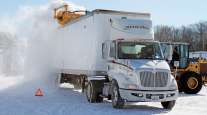Update: Large Section of Snowed-Under New York Thruway Still Closed

The New York State Thruway entered its third day of being shut down on Nov. 20 between Exit 46 in Rochester and Exit 61 in Ripley as snow continued to fall in the region.
The Interstate 190 Niagara Thruway is also closed southbound between Exit 16 at Interstate 290 and Interstate 90.
A lake-effect snow warning issued by the National Weather Service is in effect until noon on Nov. 21, with a forecast of one to two feet of snow. That would be on top of the six feet of snow that has already accumulated in some areas from the snowstorm that began late Monday in the Buffalo region, burying roads, along with cars and trucks stranded by the storm.
Winds are predicted for Nov. 20 and 21 of 20 to 30 miles per hour with gusts up to 40 mph. The snow and wind will “result in very difficult or nearly impossible travel at times in the heaviest portion" of the storm band along Lake Erie and Lake Ontario, the Weather Service said.
For those who must travel, the Weather Service said, they should “expect severe winter driving conditions with very low visibility and deep snow cover on the roads.”
“It’s bad; it’s definitely an emergency situation out there,” said Kendra Hems on, president of the New York State Motor Truck Association, on Nov. 19.
“I don’t know what the exact number is, but they have vehicles that are basically buried, both cars and trucks,” Hems said. “And it’s not just the Thruway. It’s other roads in the area.”
Cars and trucks are stranded on shoulders, in highway lanes and on access and exit ramps, she said.
New York Gov. Andrew Cuomo has declared a state of emergency, and the National Guard is helping clear snow and rescue stranded motorists.
Thomas Connery, president of New England Motor Freight, said four of his drivers were stranded on the Thruway for 30 to 35 hours, but they since have been able to return to the terminal.
"Fortunately, those drivers were prepared and they had sufficient fuel, warm clothing and food with them," Connery said.
Photo: Lake effect storm near Buffalo closes part of @NYSThruway8790 with significant snowfall pic.twitter.com/bOYHZIBUZB
— Andrew Cuomo (@NYGovCuomo) November 18, 2014
Connery said his terminal in Tonawanda, New York, with about 50 drivers, was shut down mid-day on Nov. 18.
"We put a few drivers out today (Nov. 19), but with the major roads closed around the area we haven't been able to move or deliver much freight in the last 36 hours," Connery said.
In some areas, snow fell at a rate of 6 to 7 inches an hour, building to 6 feet in 24 hours, Hems said.
“Even having your full force of plows dispatched, there was no way they were going to keep up with that rate of snow, so, it’s a horrible situation,” she said.
The National Weather Service has said the storm could break records for heavy snowfall.
There is anger and frustration among some truckers and others about whether the Thruway was prepared for the storm and whether it should have closed earlier than it did, Hems said.
Tandem trucks were ordered off at about 3 a.m. Tuesday morning, and within two hours, the stretch of the highway running east-west through Buffalo into Pennsylvania was closed, she added.
UPS said it shut down operations in Buffalo Nov. 19 because the roads were closed. As for Nov.20, "if the roads are open, we'll be on then," said UPS spokesman Dan McMackin.
FedEx said it had no or only partial service in some areas due to closed roads but was restoring service as soon as possible.
“FedEx has 15 full-time meteorologists on staff around the clock, and we’re closely monitoring the severe winter storm,” said FedEx corporate spokeswoman Jennifer Caccavo Cordeau. “As always, our top priority is the safety of our team members, as well as continuing to provide the highest level of service to our customers. Some customers may experience service delays in areas with poor road conditions. As always, FedEx is committed to providing service to the best of our ability in areas that can be safely accessed.”
The snow in Buffalo was for stories and history books. Another 2 to 3 feet is expected http://t.co/YmkgUqDB9K pic.twitter.com/54qwagibmE
— The Boston Globe (@BostonGlobe) November 20, 2014


